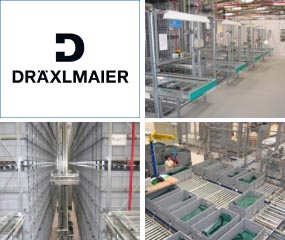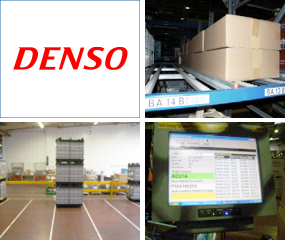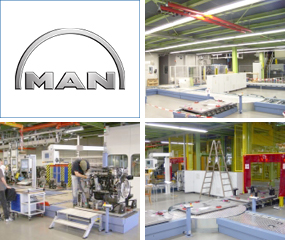![[Translate to English:] Klinkhammer Group - Imperial [Translate to English:] Klinkhammer Group](/fileadmin/user_upload/Bilder_Content/KLH-Imperial.jpg)
The Customer
Imperial has been offering competent solutions for all commodity and data flows along the supply chain. Services encompass partial and complete loads as well as JIT shipments.
The Requirements
Just as many other automotive groups, Europe's largest automobile brand as well continues to outsource the supply of production and spare parts to certified partner companies. In close cooperation with the partner companies and as interface between manufacturer and supplier Imperial takes over the supply of the desired cable harnesses for cockpit and engine compartment to the assembly area. These cable harnesses must be supplied to the assembly lines in the correct order, without interruptions and in a fully automated manner.
The Solution
Anyone who wants to supply round the clock 420 cable harnesses per hour to 210 cars of different type needs to have a highly redundant solution that is in large parts fully automated and well-thought-out. The Klinkhammer planning specialists deliberately decided to do without robots and go for sequencers (one each per assembly line) and container stackers. Here, an intelligent system layout is of vital importance in which all parts are interacting optimally. Even with regard to technology, Klinkhammer abstained from complexity in favor of a fail-safe operation. To a large extent, standard components are used which can be replaced quickly and without any problems. In a hall with a floor print of 100 x 100 meters there are two automated small parts storage blocks featuring 54,400 container storage locations and 11 automated storage and retrieval cranes, conveyors, storage and retrieval stations.
Whereas block #1 of the automated small parts warehouse (40,800 container storage locations) collects the cable harnesses and buffers them until they are called for pre-assembly, block #2 of the automated small parts warehouse (13,600container storage locations) stores the highly available parts in towers. Here, the corresponding cable harnesses for the passenger compartment and the engine compartment are"married" per type and sequence, but accommodated in own containers. By continuously comparing the data from production with the parts stored and available a constant supply of the four assembly lines can be guaranteed. Another chief attraction is the fully automated, just-in-sequence loading and unloading of the trucks with cable harnesses which is already in the sequence of the planned production.
Advantages for the Customer
With the logistic solution realized by Klinkhammer the just-in-time/just-in-sequence supply of the module and final assembly lines reaches a new dimension of quality. Imperial is able to further streamline the processes and to score with an even higher reliability. Reference sheet (PDF)

The Customer
Dräxlmaier stands for automobile innovations and modern vehicles – from the first idea to the electrical supply system ready for series production, the complete interior, high-quality trim parts or door-/cockpit modules. In Emden, Dräxlmeier supplies cable harnesses for the Passat to the Volkswagen factory. Klinkhammer has been awarded the contract of building the JIT-warehouse and providing the high-performing equipment technology.
The Requirements
Up to 120 cable harnesses leave the warehouse per hour. The cable harnesses are supplied on pallets; repacking into containers is initiated by the host system. A fully automatic handling device ensures the supply of empty containers by destacking them from pallets.
The Solution
On the container conveyor system (goods in conveyor) the barcode of the cable harness is read and married to the transponder (RFID) in the container base. The warehouse system with six racking units is served by 5 automated storage and retrieval cranes which incorporate a retrieval mechanism for containers (automatic small parts warehouse). The cranes can work in two racking units – this means that a malfunction or failure of a device does not have an impact on the access possibility to one inside racking ("reach-through automated storage and retrieval crane").
The division of the warehouse in zones ensures the relocation of containers due to intermediate product call-offs by VW. They indicate the production progress of a vehicle for which a specific cable harness must be made available. Hence, a container is first relocated from outside to inside, then from the top to the bottom. This ensures that in an emergency case manual access to the container is possible as well. A control station visualizes the condition of system and orders. When retrieving goods to be delivered to one of the three assembly lines, the order information (assembly line, production cycle, stacking order) are written to the transponder. An automatic applicator attaches the customer label to the container. The person working at the check workstation takes the part out of the container and then ensures onward transportation of the container. A handling device then stacks the containers in the predefined sequence according to the order data. The Klinkhammer warehouse management system communicates order data and warehouse movements to the in-house system (by DFE). A cluster server exists for normal operation; a hot standby system is available which is always ready to assume the function of the cluster server.
A cold standby server is used to cover the failure of a single server or of a cluster node and thus completes the highly available system. Multi-level emergency concepts guarantee the availability of the entire system. Finally, Dräxlmaier also operates an automated warehouse realized by Klinkhammer in Ingoldstadt which provides Audi with components just-in-sequence. Reference sheet (PDF)

The Customer
In the factory built in Telford, near Birmingham, in 1990, Denso manufactures air conditioning units and heating units for vehicles. Denso is part of the Toyota group of companies, but also supplies products to other automotive manufacturers. Warehouse and production facilities are all under one roof.
The Requirements
The warehouse management system starts a picking order as soon as the material stored next to a production machine falls below a certain minimum stock quantity. Within 15 minutes, order processing must have been completed; otherwise the machine will come to a standstill. The warehouse comprises a high-bay pallet zone with four levels, a flow rack area for pallets, another flow rack area for containers, a free space for articles with a very high stock rotation and finally a bin storage system for slow moving items.
The Solution
The article master data define the storage area in which an article is stored and under which conditions a replenishment order between the two areas is triggered. In the goods receiving area, at first the goods delivered are sorted according to warehouse areas. In the pallet areas, the operation is ensured by forklift trucks which are equipped with a built-in RF terminal. The container areas are handled and operated by employees being guided by portable RF terminals and carrying along hand carts. All warehouse movements - registration of incoming goods, storage, relocation, picking, stocktaking and quality checking - follow the man-to-goods principle and are processed using the aforementioned RF terminals.

The Customer
The engine production plant in Nuremberg manufactures diesel engines. These engines all feature emission class Euro 4 and Euro 5 and - looking ahead - also Euro 6. For 6-cylinder engines with common rail fuel injection of the series D20 and D26 the so-called cold testing of the latest technology is used.
The Requirements
For transporting the engines on the conveyors, they are placed on aluminum cast pallets. The overall weight amounts to 1.5 tons. The carrier pallets run on the skid conveyors made by Klinkhammer and especially designed for MAN. The conveyor modules have been adapted to each workstation.
The Solution
Working cycle: At a lifting station, the engines are placed on the empty carrier pallets (skids) and then travel to the first workstation. These workstations have been specially designed for the ergonomic equipping and removing of test engines. When working, the worker stands in front of the engine (barrier-free access) and works at the outer side of the conveyor system. The conveyor technology has been designed such to be accessible and the cover extends all the way down to the floor. At turning stations the engine is turned by 180°. Equipped engines are then directed to the safety cell of the testing bench. Using a crossways transfer car, the motor is first routed to the fuel filling station and then to the test. The skid is entered into the cold testing and after the test placed again on the crossways transfer car. During this process, the transport rollers are decoupled from the engine. In case of a failure, rework on the engine can be done at three subsequent repair workstations. Following repair, a bypass conveys the engine again to the retesting station. The engine data determined is written into the engine electronics at two flash stations. Finally, the engine - turned back into its original position – drives back to the overhead conveyor system via a second lift and the empty carrier pallet returns to the starting point.
For the purpose of data tracking the carrier pallet is equipped with transponder chips (RFID). The reading units are integrated into the conveyor system. Klinkhammer realized the PLC-control system, the visualization and the interface for operating data collection, remote maintenance, test bench etc. The system has been designed for a three-shift operation. The engines can be processed at intervals of 3 minutes. When extending the test capacity, the interval is reduced to 1.6 minutes. At a degree of utilization of 80%, 120 engines or 225 engines can be tested per shift. A visualization system simulated the system capacity in the project preparation phase.